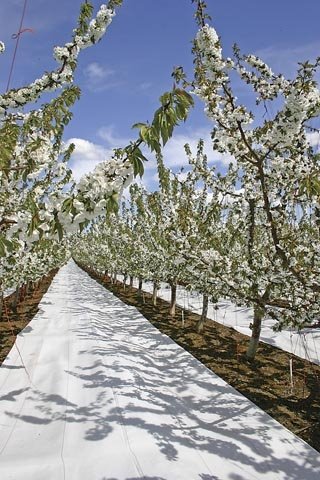
After several years of study by Washington State University researchers and use in commercial orchards by cherry growers, there are few negative comments about a reflective material that seems to promise the moon—advanced maturity, increased size, reduced number of pickings, and high yields.
Dr. Matt Whiting, WSU horticulturist, has been collecting data comparing different types of reflective material in field trials since 2004. The material has been evaluated under numerous variety/rootstock combinations, including Bing on Gisela, Rainier on Gisela and Mazzard, Sweetheart on Mazzard, and Chelan on Mahaleb. Initially, he didn’t see fruit set improvements from the reflective treatments, but in the last two years, he has observed higher yields, advanced maturity, and better color.
New Zealand researcher Jonathan Toye developed the reflective materials that are sold under the trade names Extenday and Daybright. Daybright is less reflective than Extenday and allows for greater soil warmth. The materials come in different widths.
“We learned in 2006 that you can apply it too early,” Whiting said in presenting highlights from the data collected in 2006 at the annual meeting of the Cherry Institute held in Yakima, Washington. They laid the material down cherry orchard rows in late March during bud swell. “The results were less than compelling by putting it down so early. We didn’t see the improvement in size that we saw in years past.”
He believes that the cooler spring weather last year, coupled with putting the material down on cool, wet soil, may have contributed to the lack of size differences in the Bing, Rainier, and Sweetheart trials.
The Daybright material, which is less reflective and lets more light through the material, was tested last year in a Chelan-on-Mahaleb trial, Whiting noted. “Again, nothing really jumps out in terms of fruit size. But we did have 11 percent higher packout, 3 days of advanced maturity, and 2º Brix higher in sugars. There was an impact on color, but the fruit were not smaller or larger.”
In a high-density Sweetheart on Mazzard orchard in Quincy, Washington, the Extenday trial resulted in slightly higher proportions of 9- and 9.5-row (large) cherries than the control in response to two years of treatment, he said.
“The trees are setting more fruit buds at the base of the tree, which is why you find higher yields in the second year of treatment,” he explained, adding that the total tonnage was 40 percent higher in the second year.
Whiting still has several questions about the reflective materials he would like answered. For example: What is the interaction between application timing, soil temperatures, and light conditions? Can size and color of late varieties be improved without advancing maturity? And, what is the timing and ability to improve quality for midseason varieties?
“I think that we probably should be treating varieties and training systems differently,” he said. “Maybe we need different pruning strategies to let a little more fruit hang on the trees.”
Grower experiences
Bob Pringle, an orchardist from Naches, Washington, with nine years of experience using the same Extenday material, can attest to the durability of the product. “It will last a long time if treated right,” he said.
“You must be gentle and be nice to it, covering it in the winter and protecting it from the sun.”
He uses it primarily in his Rainier blocks to improve color, laying it down when the cherries just start to color.
“I figure that I paid for it in the first year,” he said, adding that he is able to pick his Rainiers in one pick. The material has also helped him reduce humidity within the orchard and reduce mildew sprays. Typically, he only has about 2 percent culls from his Rainier cherry crop.
Pringle began laying the material down every other row last year in a Bing orchard because he was starting to lose production on the lower branches and leaves were smaller at the bottom of the trees. After seeing good results, he plans to lay it down the rows that were untreated last year.
Weeds are a drawback if Extenday is put down early, he noted, because weeds can’t be controlled once the material is in place. “Weeds grow well underneath it.”
He recommends laying the material over a cover crop with four to five inches of growth rather than over bare soil because it lays down better.
Timing and temperature
Travis Allan, an orchardist from Yakima, used Extenday for the first time last season on a ten-acre cherry block. He wanted to achieve a three-day advancement to better schedule picking crews.
“We felt it was a success,” Allan said. “Next year, we plan to use the material on half of the block. I liked being able to move the crop earlier.”
They placed the material in the orchard after petal fall but will try this year to place it down during full bloom.
“We didn’t see any color improvement, but then we already have good light interception in the block. But we did see early advancement of fruit maturity.”
He admitted he was nervous last summer when temperatures reached 100°F, not having experience with the material and heat. To measure if the high temperatures resulted in negative effects when combined with the reflective material, they pushed some of it under the trees, but left a row for a control and collected temperatures with a data logger. “If the water was sprinkled over the material down the rows, the high temperatures didn’t seem to affect it any,” he concluded.

Leave A Comment